100% Phoenix, 0% Traffic:
Bike Touring the Canals of the Salt River Valley
By Greg Heil
Hi, my name is Greg, and I live to ride new mountain bike trails. I began writing about mountain biking in 2010, and over the years, I’ve explored thousands of trails across North America, Europe, and other far-flung corners of the globe. Even when I’m not riding, you can find me active outside 365 days per year.
Phoenix
If any major American city has been built around the automobile, it is Phoenix. The city is laid out on an almost perfect grid: if you ask a local where they live, they inevitably refer to the two closest cross streets… and you had better know exactly where Dobson and Broadway are located in the massive span of the Salt River Valley.
Running through and above the grid of wide surface streets is a snarled freeway system that seems like it’s close to being completed, but is never quite finished. The constant population growth of the greater metro area drives this constant construction—where once two-lane farm roads traversed irrigated alfalfa fields and orchards, now 12-lane highways roar through the endless sprawl of subdivisions.
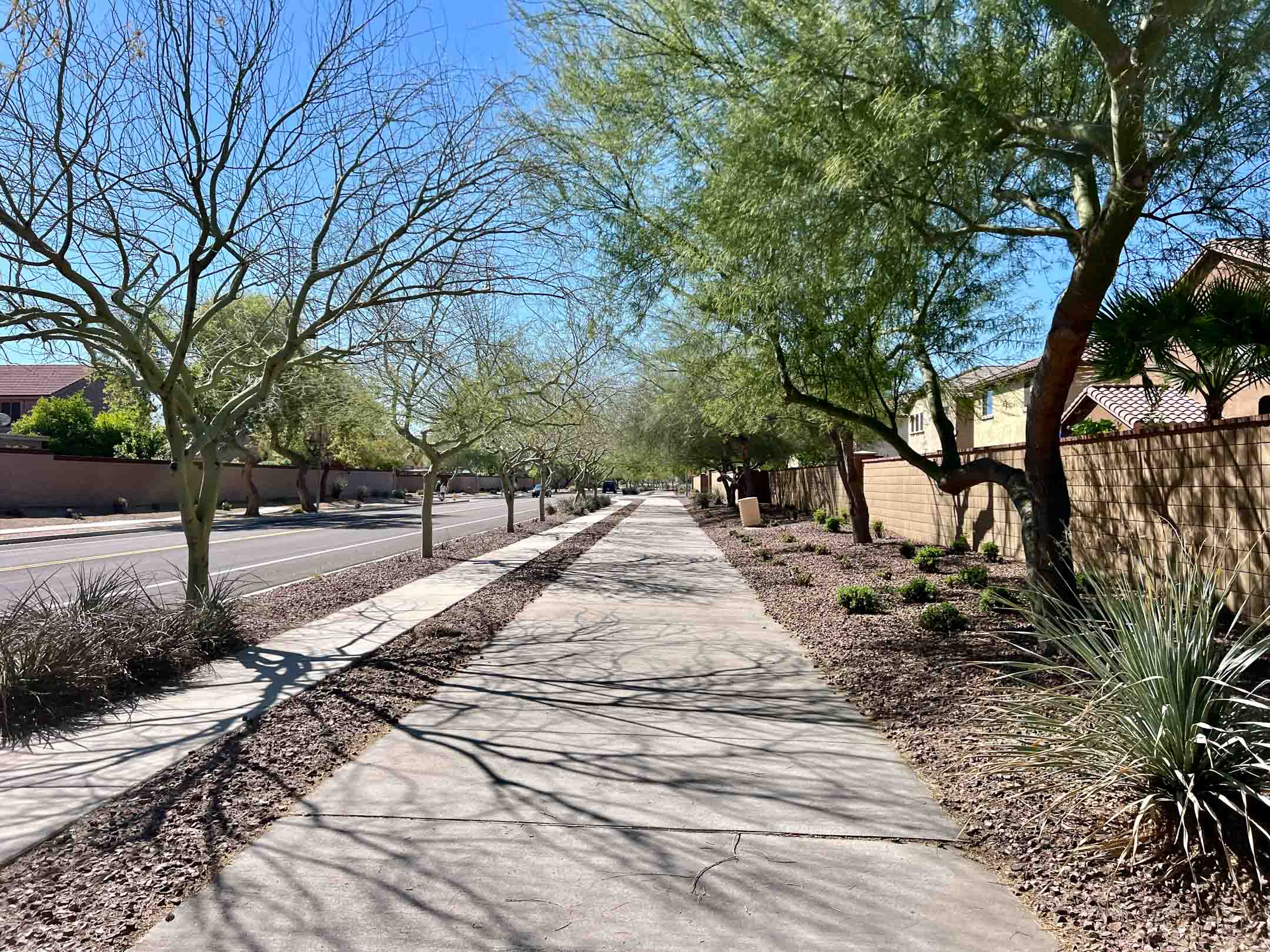
Thanks to this propensity for building (and developing) for cars, one adjective that's never used to describe Phoenix is "bike-friendly." While cities like Portland, Minneapolis, San Francisco, and Denver earn accolades for their bicycle infrastructure, Phoenix is nowhere to be found on such lists.
So while the nation at large might not think to pedal their bikes around Phoenix, locals (and those snowbirds who spend enough time there) are in on a little secret: the riding in Phoenix is fantastic!
An expansive network of paved greenway trails and gravel canal paths lace the valley, forming an incredible infrastructure that connects even the most far-flung suburbs. These paths generally follow canals used to transport water into the arid city or dry riverbeds and drainage ditches that only flow during the wettest years. Thanks to these long-distance waterways, you can pedal for miles and miles just following one single canal before taking a turn onto an adjacent drainage ditch and pedaling for dozens of miles more.
My wife Christine and I had enjoyed a few lengthy rides on this system of bike paths in years past, and the nucleus of an idea formed: to attempt a circumnavigation of the valley by utilizing these traffic-free bike paths and the city's infrastructure to ride light and fast. A classic bike tour, in other words.
Phoenix’s suburban layout lends itself exceedingly well to bike touring. While the long distances and wasted space between housing developments and commercial areas are terrible for a bike commuting lifestyle (where density is prized above all), the expansive suburbs and widespread restaurants, grocery stores, and hotels provide a unique opportunity among North American cities for a spectacular multi-day tour.
Maricopa Trail
A designated route known as the Maricopa Trail circumnavigates the valley on a massive 315-mile loop, and on the surface, it might seem like the ideal route for a big bike tour. But in reality, the Maricopa Trail isn’t great for either a mountain bike or a gravel bike. The problem is that the official Maricopa Trail follows paved bike paths and gravel canal paths, but then it also traverses long stretches of rugged singletrack, some of which head deep into the foothills far from the city. In order to create a route that would be rideable entirely on a drop bar bike, I had to go back to the drawing board and build my own loop using a variety of maps and online resources.
Eventually, I crafted a 150-mile loop that effectively eliminated riding on open roads by utilizing this system of greenways and canal paths (some portions of which are indeed the Maricopa Trail alignment). By the time we detoured to lunch stops and hotels, our four-day, 150-mile loop grew to 166 miles of riding.
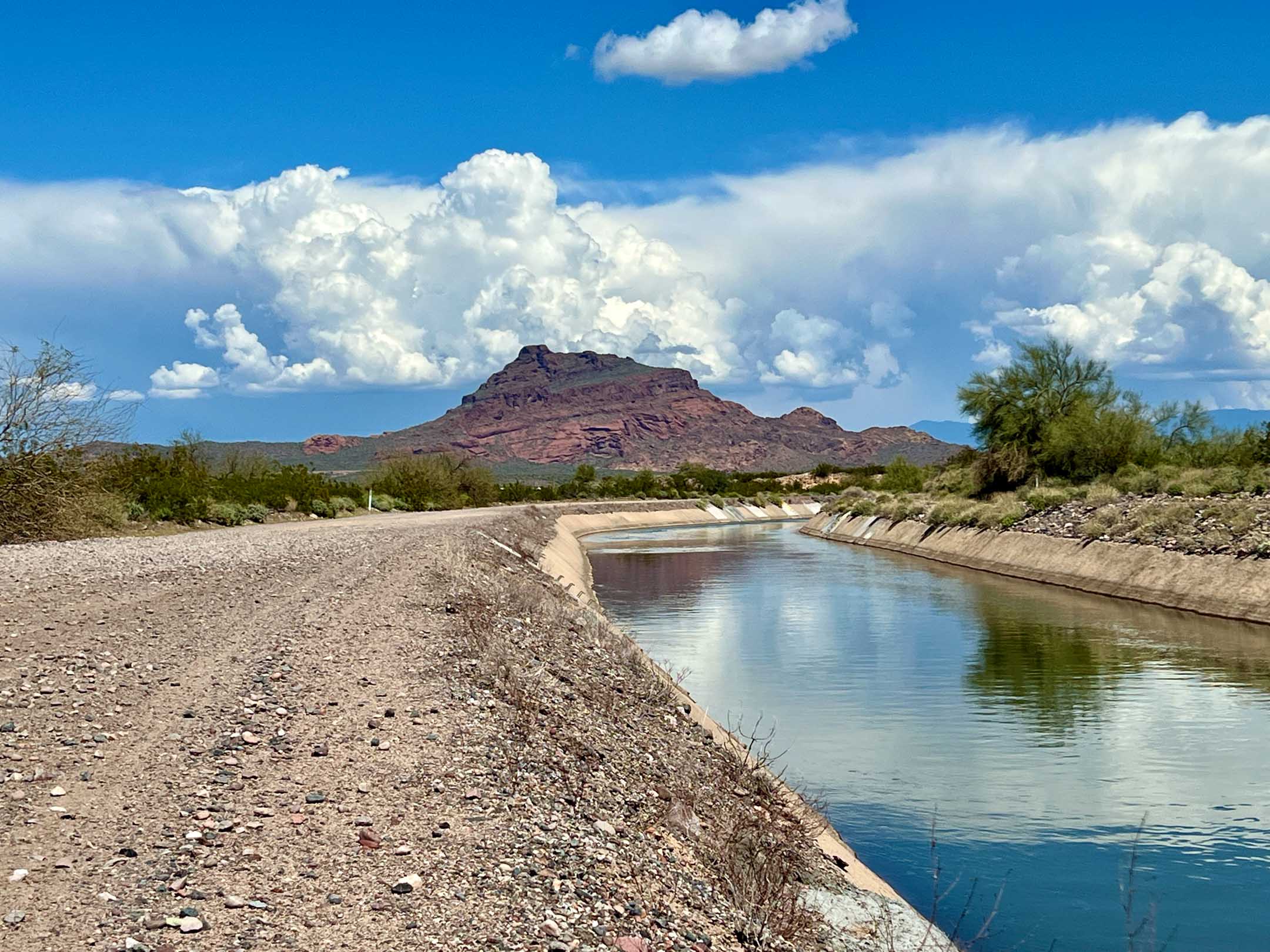
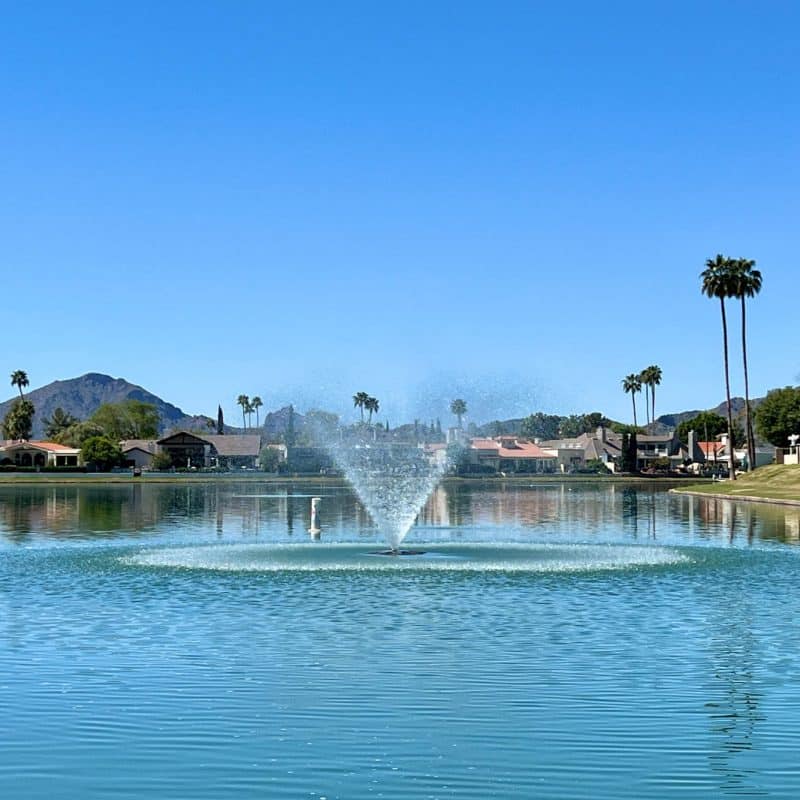
A Land of Facades
In many ways, Phoenix is a land of facades. As we rode around the city, we were constantly confronted by the false fronts that people erect around their lives. We pedaled past fake lakes in the desert where none should exist, canals and pathways reminiscent of Venice yet found in a harsh desert landscape. Breathtaking mansions, hiding behind their fences, walls, and gated communities stand where once indigenous peoples trod. Literal southwestern facades grace the fronts of strip malls built of concrete and steel underneath.
As cyclists pedaling through this landscape, we had the chance to see past all of these veneers. So much cycling infrastructure is built in the spaces in between—the spaces that were deemed unusable for automobiles and unbuildable for the newest subdivision. And yet, cyclists, runners, and dog walkers now flock to these places that were once abandoned. As we traversed these in-between spaces, we got to literally look past the carefully-erected facades as we peered over fences into the backyards of mansions, pedaled our way through industrial parks, and wound our way through both the newest and oldest parts of the city.
And as we looked past the obvious over these four days, we saw a picture of what Phoenix used to be. We pedaled past orange groves and ranches harkening back to the valley’s agricultural history while simultaneously realizing that even the agriculture is just a different facade glossing over the indigenous history of the region and the truly rugged, arid desert landscape predating any human attempts to irrigate this landscape.
Thankfully, on the far northeastern corner of the loop, we pedaled so far out of the city that we still enjoyed a taste of the true desert landscape—with towering saguaro cacti standing sentinel and scrubby mesquite trees and prickly pear cacti predominating. This delightful but remote section was short-lived, before we were faced with one face of the vicious underbelly of every city—trash, and lots of it, as we pedaled past one of the valley’s biggest landfills.
A Land of Juxtaposition
It doesn’t take long to realize the extreme juxtapositions presented by all major cities, and as we pedaled from the pristine beauty of the desert past the ugly affront of a landfill, we got our first major dose of Phoenix’s own contradictions. The next day, we began our ride by pedaling along some of the most beautiful bike paths in the valley—those winding along the golf courses and artificial lakes in the ritzy suburb of Scottsdale. The golf courses give way to a vibrant downtown, where the bike path travels through the heart of the hip downtown district, providing our easiest lunch stop of the ride.
But by the end of this day of riding, we found ourselves pedaling through endless homeless camps in North Phoenix. One stretch in particular stood out—out of the corner of my eye, I noticed two people sitting on a couch in the dry wash, about 30 feet off the bike path. A few feet later, the word “trick” was spray painted onto the pavement, with an arrow pointing to the waiting women on the couch. We then ducked under a bridge, past two guys shooting up in the shade, and emerged to see a group of white men in polo shirts whacking white balls with shiny sticks, driving around in golf carts that completely eliminated the need to so much as walk.
This juxtaposition is present in cities both large and small, all around the world. If you haven’t seen it, then you haven’t been looking hard enough. Pedaling through these spaces in between allowed us to experience the beauty of the greenways and canals, yes, but it also provided a first-hand perspective of the other people who use these in between spaces. While there are no easy answers, it seems to me that the first step is to refuse to ignore the problem but rather acknowledge that it exists—that these people exist. And hopefully, one day, we can do better as a society.
Hundreds of Miles of Gorgeous Pedaling
The best travel experiences take you out of the carefully-constructed bubble of your normal, everyday life and force you to question reality as you know it. While a bike tour around Phoenix might not seem exotic enough to count as “travel,” the experience still challenged our beliefs and our preconceptions about society. But as we cranked away for mile after mile and day after day, it wasn’t all existential rumination and half-baked plans to change the world. Rather, the majority of the trip consisted of good old-fashioned riding.
We enjoyed more beautiful moments than we could count. Christine and I were constantly pointing out the many amazing birds we saw along the way—herons, an egret, cactus wrens, thrashers, hummingbirds, a Vermilion Flycatcher, and even a burrowing owl that stopped and looked us square in the eyes. On our longest day of riding, we began our 54-mile pedal in the cool of the morning, with the low-angled sun shining through blooming flowers—absolutely magical!
Despite pedaling through endless evidence of human development, the natural beauty of the route was still breathtaking. We enjoyed the sound of rushing water in the canals, the desert cacti and blowing sand in the outer reaches, views of the mountains in the distance, the green grass and fountains of the golf courses, and the artificial yet still beautiful display of falling water at Arizona Falls.
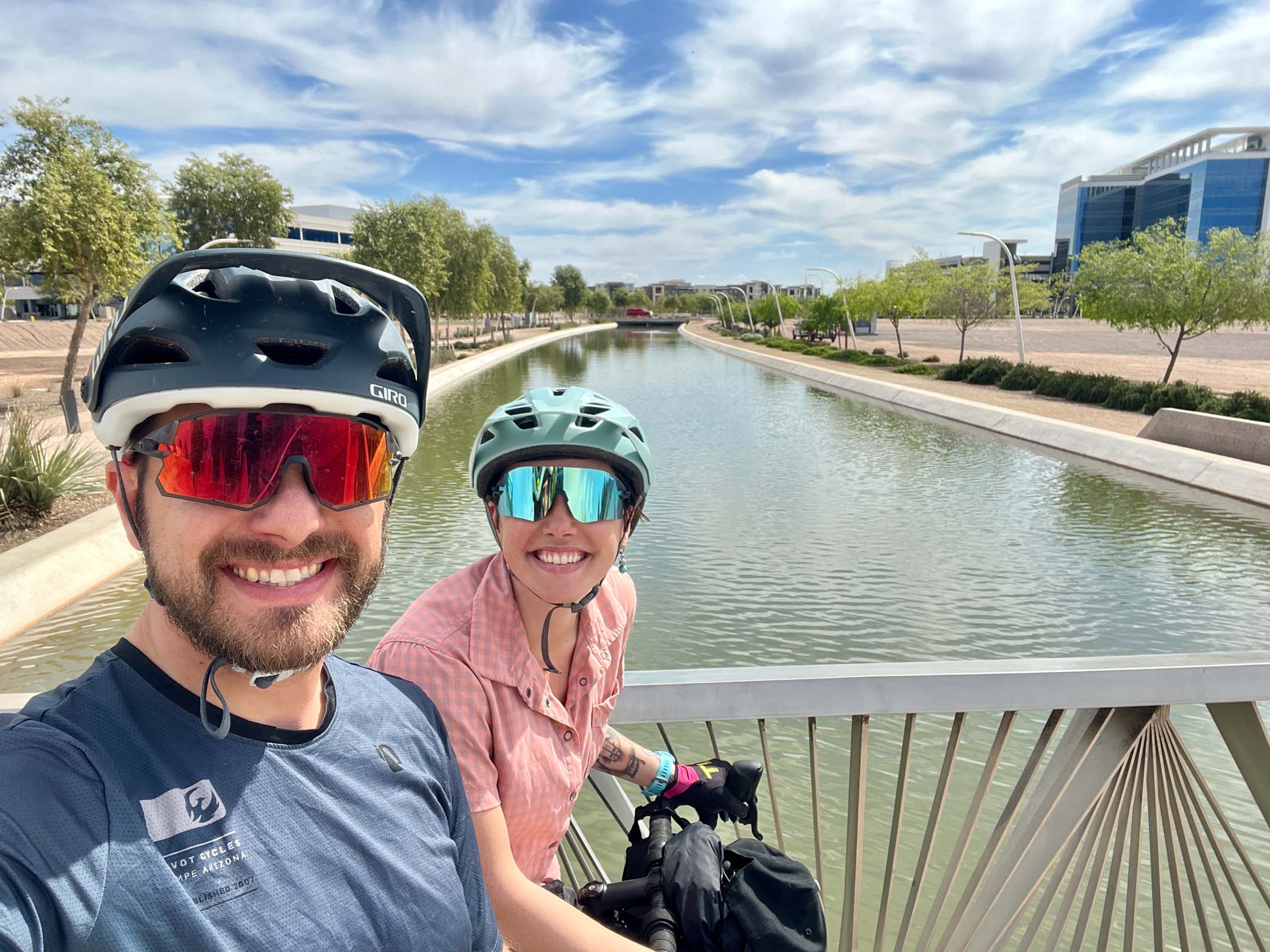
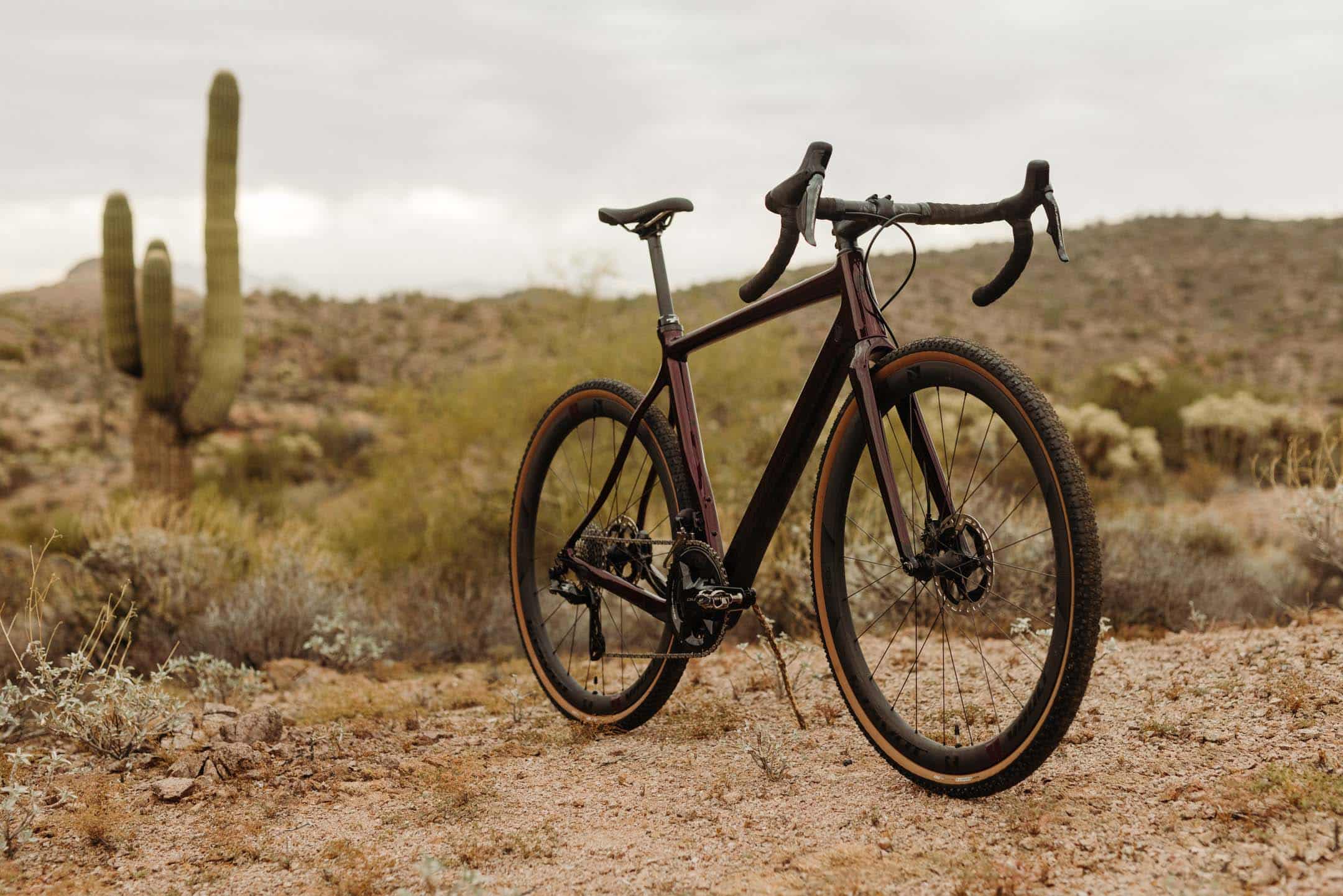
Whizzing Along
As we whizzed along smooth bike paths and then bounced across railroad tracks onto a rough gravel road, I felt validated in my belief that a gravel bike was the perfect tool for the job. While we passed endless road cyclists, an epic loop of this nature required grinding many, many miles of gravel. In the northern (and most adventurous) sections of the loop, we even rattled along rocky singletrack trails through the bottoms of washes to make critical traffic-free connections.
The Vault handled the ever-changing conditions admirably, providing top-end speed and efficiency on the pavement and plenty of burl in the tires when the going got rough. I opted for the WTB Byway tires for this ride—with a hard fast-rolling centerline but small knobs on the outside, this type of tire is ideal for a mostly-paved or well-packed gravel ride. When the going got sandy, the Byway got a bit squirrely, but I was still pleased with my choice. You can, of course, run a knobbier gravel tire, but it’ll just be a bit slower on the pavement (and you’ll wear out your tread).
Regardless of tire choice, the durable Reynolds BL G700 Experts (on my bike) and the Reynolds ATRs (on Christine’s) provided peace of mind as we hopped up curbs, ripped down singletrack, and hit innumerable unexpected bumps and obstacles throughout this epic four-day loop. Despite punishing the bikes on constantly changing terrain, rowdy singletrack connections, and even pedaling through standing water as we made a critical connection under yet another car-centric freeway, our pair of Vaults performed superbly and without a single issue.
Water in the Desert
Four days, 166 miles—while we could have undoubtedly completed the loop in a shorter amount of time, spreading it out allowed us to truly soak in and savor the experience. But if you want to pedal faster, a 3-day tour of the city is still very achievable. If you want to attempt the route—which I’m dubbing the “Water in the Desert Loop”—for yourself, you can find a map embedded below.
Note that we did have to make some detours for trail closures, standing water, locked fences, and to reach hotels, some of which are not shown here. But the beauty of the vast amenities that Phoenix provides is that you can take this 150-mile loop and use it to create the experience that you want to have. You can pedal it faster or slower. You can add on more detours to see sights that you’ll pedal past, shorten it to remove the two small bits of road connections, or boil it down into a more concise loop.
The choice is yours—but isn’t that freedom of adventure, after all, exactly what makes a bike tour so enticing?!